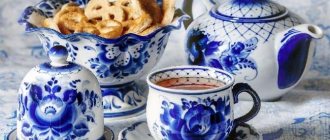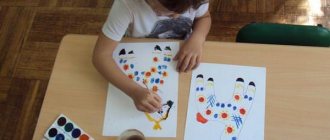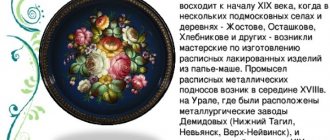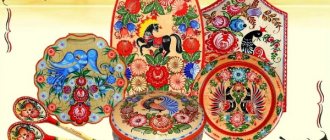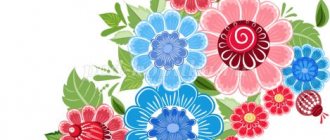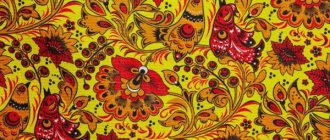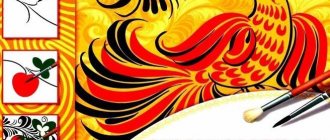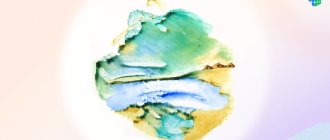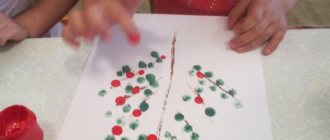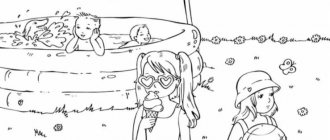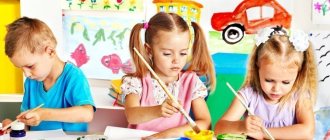Main differences
All types of Khokhloma paintings on household kitchen utensils have their own characteristics. It is from them that experts or simply knowledgeable people can talk about the creation technique. The name “Khokhloma” is one of the most popular among paintings. Not only experienced artists, but also preschoolers can learn to draw step by step. Khokhloma painting patterns for beginners include:
Grass patterns - a line curved to the side. To get it, you must first press the brush in the center, and then, moving it to the side, gradually reduce the pressure and gradually reduce the thickness.- Leaf is one of the simplest patterns. Mirror blades of grass are drawn, curved outward. All empty spaces are filled with paint of the same color.
- A curl curled like a snail is less common because it is more difficult to draw. It is important to maintain equal pressure on the hand.
- Droplet - the brush is placed at the base of the bristles and slowly turns 180 degrees, slightly moving forward and lifting off the surface. Drawing droplets helps train your hand to press correctly.
- A bush is a few droplets arranged in the form of a fan. A small dot is placed at its base.
Abstract of OOD on drawing in the preparatory group of the kindergarten “Khokhloma painting”
Summary of organized educational activities
in drawing in the preparatory group “Khokhloma painting”
Author: Alena Sergeevna Nikolenko, teacher of MKDOU “Podgorensky kindergarten No. 1”
Integration of educational areas:
“Cognitive development”, “Artistic and aesthetic development”, “Speech development”, “Physical development”, “Social and communicative development”.
Target:
introduce children to the Khokhloma painting patterns.
Objectives:
Educational: - Continue to introduce the art of Khokhloma. — Replenishment of vocabulary. Developmental: - Continue learning to draw a pattern in a certain sequence (border, branch, berries, curls). — To develop the ability to combine in a pattern the colors characteristic of Khokhloma painting: black, red, gold (ochre). — Develop children's creative abilities. Educational: - To cultivate accuracy and the ability to objectively evaluate children's work. -Cultivate interest in arts and crafts through artistic activities.
Demo material:
an easel, a table with various Khokhloma dishes, illustrations, objects with Khokhloma painting, preparations for laying out the composition - cardboard pots, a brush, gouache, a napkin, a stand for brushes, a jar of water.
Handout:
Cardboard blanks, gouache, fine-tipped brush, jar of water, napkin.
Preliminary work:
Examination with children of illustrations about Russian huts, clothing, and life.
Learning proverbs, poems, folk games. Introducing children to Khokhloma paintings. We held conversations and drew Khokhloma patterns. OOD move:
- Guys, look, I have a magic box, the postman brought it to us.
- Let's see what's inside this box? - What is this? - That's right, guys, these are puzzles, you need to put them together to find out what we will be learning about today. Didactic game “Assemble puzzles”
- What did you get?
— How can I call all this in one word? (dishes)
- Today we will talk about unusual dishes. I invite you to the “dishes exhibition”. -Are you ready to come with me?
(The music “Fair” is playing. The group has organized an exhibition of Khokhloma products, illustrations depicting Khokhloma dishes.)
- Look guys, how beautiful it is around! It was as if we had entered the kingdom of Golden Khokhloma! - And what is there: Ladles, cups, spoons and wonders - ladles. You'll see, don't rush. Here the grass curls and flowers of unprecedented beauty! They shine like gold, as if bathed in the sun.
— Guys, do you know how Khokhloma painting appeared? — I’ll tell you the legend of how Khokhloma painting appeared. — There lived in ancient times a master icon painter. The king highly valued his skill and generously rewarded him for his work. The master loved his craft, but most of all he loved a free life and therefore, one day, he secretly left the royal court and moved to the deep Kerzhen forests. He built himself a hut and began to do the same thing. He dreamed of an art that would become familiar to everyone, like a simple Russian song, and so that the beauty of his native land would be reflected in it. This is how the first Khokhloma cups appeared, decorated with lush flowers and thin branches. The fame of the great master spread throughout the land. People came from everywhere to admire his skill. Many people built huts here and settled nearby. Finally, the master’s fame reached the formidable sovereign, and he ordered a detachment of archers to find the fugitive and bring him. But popular rumor flew faster than the archers’ feet. The master learned about his misfortune, gathered his fellow villagers and revealed to them the secrets of his craft. And in the morning, when the royal envoys entered the village, everyone saw the miracle artist’s hut burning with a bright flame. The hut burned down, and no matter how hard they looked for the master himself, he was nowhere to be found. Only its colors remained on the ground, which seemed to have absorbed both the heat of the flame and the blackness of the ashes. The master disappeared, but his skill remained, pleasing the eyes and souls of people to this day. And since all this was in the village of Khokhloma, the painting began to be called Khokhloma. — Let's admire the products of Khokhloma masters. -What do you see? Describe verbally what kind of dishes? ( beautiful dishes, bright, joyful, rich, colorful
) - What material is this dish made of?
(and from wood
) - Do you know why Khokhloma is called golden?
( On all products there is a gold color: on one item there is a background, on another there are leaves, berries, flowers in patterns
).
— Take the Khokhloma dishes in your hands and look at them carefully. — What colors do artists use in painting? ( Red, black, yellow and green may be present
).
— What colors does the artist use for the background? ( Red, yellow, black
) - Name the elements of the pattern in Khokhloma painting?
( Curls, blades of grass, droplets, icicles, leaves, berries
).
— What kind of berries do the masters draw? ( Raspberries, strawberries, mountain ash, cherries, gooseberries, lingonberries
).
- Well done boys. - Guys, who can tell me what a fair is? - What do they do at the fair? — That’s right, at the fair they sell products, buy goods, have fun, sing songs, play games. “I invite you to play the Russian folk game “Dawn, Zaryanitsa - Red Maiden” at our fair. Russian folk game “Zarya, zaryanitsa - red maiden.”
- Well done boys.
Game “Find an element of Khokhloma painting”
-
In front of you are elements of paintings, find the elements of Khokhloma painting and name them. - Well done, you all completed the task.
— Guys, guests from other countries come to our country and everyone wants to take some kind of souvenir from Russia as a souvenir. Guests go to special stores - art salons and buy Dymkovo horses, painted matryoshka dolls and, of course, elegant Khokhloma products!
Through the mountains and seas, the whole world admires - Oh yes, a Russian souvenir! Oh, what a miracle the colors are! And fairy tales and Khokhloma’s smiles roam the world.
— Guys, I suggest you open your own art salon so that our guests can also choose a souvenir as a keepsake. But first, we need to become artists - masters and paint the dishes with the Khokhloma pattern. - Do you agree?
Productive activity
— You have silhouettes of dishes on your tables.
—Where will you start your work? ( From the background of the product and from the border at the top and bottom
).
— What element of Khokhloma painting will you paint next? (The curl is the main element of Khokhloma painting, because all other elements are painted on it
).
- What will we draw on the curl first, what then? ( First large elements: leaves, berries, then small elements: droplets, grass, curls
). - Well done guys, you know everything like real masters.
- Now, let's go to the art workshop and get to work! Surprise your guests with Khokhloma patterns! • Sedges are the simplest element of the pattern. It is performed by lightly moving the tip of the brush from top to bottom.
•
Blades of grass are strokes with a slight smooth thickening.
•
Droplets are drawn by applying the brush to the paper.
•
The antennae are drawn as a continuous line of equal thickness, twisted into a spiral.
•
Curls are performed with light pressure in the middle of the element.
•
The bush is the most complex element; all elements of the herbal ornament can be involved in its image.
(Children perform productive activities to the music “Russian Melody”)
- Well done boys! You have made wonderful Khokhloma dishes. - Let's put it in our art salon. (An exhibition of children's works is being organized.)
- Admire the wonderful work we have done.
(Children look at the work, the teacher reads a poem).
Like the sorceress Firebird, the sorceress-craftswoman, Golden Khokhloma, does not go out of her mind. Both rich and beautiful, I am glad to see the guest from the bottom of my heart. Cups, bowls and ladles. And what’s missing here: Bunches of fiery rowan trees, poppies of sunny summer, and daisies of meadows. She absorbed everything, like a memory: The dawn of red rays And the patterned ornament of Ancient Suzdal brocade. The leaves turn red without thinning, from the breath of winter. Enters the kingdom of Berendey into the world of magical Khokhloma.
- Well done, guys, we have created real Khokhloma dishes that are so pleasing to the eye. - Thank you guys for such beauty!
Features of the technology
It is customary to paint wooden products with Khokhloma: toys, dishes, etc. The finished product can be given as a gift or kept for home decoration. Before you start painting, you need to prepare all the materials and tools. To work you will need:
- a wooden board for cutting food or any other item for the base;
- adhesive;
- gouache or other paints;
- egg white;
- sheets of paper;
- pencils;
- brushes for painting of different thicknesses;
- varnish for fixing the pattern;
- paint brush.
After the above list and Khokhloma painting stencils have been collected, you can begin to work.
Step-by-step master class:
- Coat the wooden base well with egg white and let it soak in a little.
- Prepare a sketch drawing on a separate sheet.
- Cover a cutting board or other object with gold paint and wait until it dries completely.
- Using a pencil, carefully redraw the drawing from the sheet onto the base.
- Color all the ornaments of flowers and berries red.
- Using a thin brush, add curls, leaves and veins.
- Mark the boundaries of the patterns and outline them thicker.
Even though the base was painted gold, the final design should give the impression that the background is still black. The finished product should be allowed to dry, then check and complete the missing elements and green grass. Secure the design with a thin layer of varnish.
Fine art lesson in kindergarten on the topic: “Spoon painting (Khokhloma)”
Summary of a lesson on art activities in the senior group
Topic: “ Spoon painting (Khokhloma)”
Program content:
-Continue to introduce children to Khokhloma products. Introduce a new element - curl. Strengthen the ability to draw berries (with a stamp), leaves, grass. Teach children to make a pattern in a circle. Convey the color of the painting, the combination of color, background and elements of the plant pattern. -Develop aesthetic perception, sense of color, composition. -Cultivate love and respect for working people.
Demonstration material:
exhibition of Khokhloma paintings, images of Khokhloma products.
Handout materials:
wooden spoons, gouache, brushes, cotton swabs, napkins, stands for brushes, cups for water.
Audio material:
song “Our Khokhloma” by Yu. Chichkov, song “Russian Spoons”
Progress of the lesson:
Russian folk music sounds. Khokhloma products
are placed on the tables in front of the children Educator: Who needs dishes for porridge-okroshka, a miracle dish and cups, spoons?
Come, honest people, to our exhibition. Don't pass by, be our dear guests at our wonderful exhibition. Admire the products of great masters. Look at these products guys. How can they be called in one word? - Dishes. — Are the dishes here the same? - No. - Here are the cups, here are the spoons, the samovar and the ladle. - What is this dish similar to? Pick up one product at a time and look at it carefully. How is this dish similar? — It is made of wood, identical elements of the pattern (curls, grass, leaves, a twig with berries), the pattern is made on a black or yellow background. - What is the name of this dish? Who has already guessed? -Khokhloma dishes Yes, Golden Khokhloma itself has come to you! A golden grass grew on a spoon, a flower blossomed on a bowl, a cranberry ripened on a ladle. There is no shame in putting such dishes on the royal table. How did this wondrous wonder appear - “golden Khokhloma”? An old legend tells: once upon a time there lived a man in the Nizhny Novgorod forests, on the banks of a quiet river. We don’t know who he is or where he came from. That man carved wooden bowls and spoons and painted them so that
they seemed to be made of pure gold.
The king found out about this and became angry: “Why don’t I have such a master in my palace?! Give it to me! Immediately!" He tapped his staff, stamped his foot, and sent soldiers to take the craftsman to the palace. The soldiers set off to carry out the royal order, but no matter how much they searched, they could not find the miracle master. He went to God knows where, but first he taught local peasants how to make “golden” dishes. In each hut cups and spoons sparkled with gold. A lot of “golden” dishes were sold at a fair in the village of Khokhloma. This is how the name “golden Khokhloma” was born. Let's remember once again what plant elements the Khokhloma pattern consists of - Berries, leaves, curls, bushes. (I demonstrate in the pictures) - Look, there are scarlet bunches of rowan, and a ripe strawberry, and curls of herbs and leaves. And most importantly - a shimmering golden background, which makes the product more elegant and festive - Guys, I noticed the basket that stands in the corner. Maybe someone forgot her. Let's look into it (take out spoons). - Someone left us these spoons. Maybe the craftsmen who brought us their products? Look, the spoons are not simple, but wooden. But they just don’t have a pattern, and they don’t look exactly festive. Guys, do you want to become real master artists of Khokhloma and paint these spoons. And now, everyone sat down at the tables together, everyone looked at me. (put on aprons) - What colors will we need to make the pattern? (black, red, green) (showing samples of painted spoons)
- Guys, look at the samples of spoons and tell me what elements make up the pattern on these spoons? - The pattern consists of a branch with berries, leaves, curls and grass. - What is the main rule when making a pattern?
(the elements of the pattern should be located rhythmically, at the same distance, repeating the elements evenly)
.
— First you need to draw a curved branch with the end of the brush. Then berries and leaves are depicted on the branch (leaves can be drawn with the end of a brush, by dipping, and berries can also be drawn with the end of a brush or by poking)
.
Then, near the berries and leaves, you can draw blades of grass - with (arched)
. But you can also draw berries with a stamp (cotton swab). Watch how I paint the spoon. In the center of the spoon we draw a curl, one after another. From the curl, I draw blades of grass with the tip of the brush. But let’s draw the berries with a stamp. - Now you will become masters - artists of Khokhloma and decorate wooden spoons with patterns. Now let's get to work. Children’s independent work is accompanied by music (the song “Our Khokhloma” by Yu. Chichkov is played.) When the children draw berries and leaves, advise them to add small details to the berries at their ends (dots or “antennae”, and veins (black) on the leaves). Analysis of children's works. - Now look and find the spoons that are most similar to Khokhloma ones, select and show the most beautiful spoon. Tell us about it: what color it is, what colors it is painted with, what berries are on the pattern, why this spoon is better than others. - Guys , you tried very hard, now our fair will be replenished with Khokhloma spoons. - The Khokhloma painting, like a witch’s, asks for a fairy-tale song And nowhere in the world are there such inflorescences Of all the wonders more wonderful than our Khokhloma And now I’ll ask the perky musicians to come out here. - Well, take the spoons apart, Start dancing with us. Song “Russian Spoons”.
Advantages of Khokhloma toys
Toymakers took suitable types of wood for work - linden, aspen, birch. The tools they used were an axe, a knife and a chisel. Each toy is a whole world for the child who receives it. The priority colors red, black and gold played in the sun, shimmered, and gave rise to interesting fantasies in the child’s head. Khokhloma toys are always elegant, bright, and attractive. They are used directly for gaming, but can also be an attractive interior element.
The Semenovsky enterprise “Khokhloma Painting” offers the modern buyer new toys, a description of which can be found in the catalog on their website. The demand for nesting dolls is traditional; they differ in decorative design, size, and number of dolls in a set. Today, colorful New Year's Khokhloma toys are also made in a wide range: from simple piggy banks to large sets with several characters.
Khokhloma matryoshka doll
The Russian nesting doll has Japanese roots. The sage Fukurama with several figures inside, brought from the island of Honshu, inspired Russian craftsmen to create a domestic adaptation. The matryoshka appeared in the 19th century, and in 1900 it won a medal at the World Exhibition in Paris. According to the sketches of S. Malyutin, the first nesting doll was made in Sergiev Posad, and this craft quickly spread throughout Russia, since local craftsmen already knew how to carve objects that nested inside each other (Easter eggs, for example).
Features of the nesting doll from Khokhloma (or, as it is correctly called, the Semenov matryoshka):
- red, black and gold dominate her painting;
- yellow, green and brown colors help convey the precision of the drawing;
- the floral ornament is stylized, but quite detailed;
- This toy looks more elegant than Vyatskaya, for example.
But if you decide to draw a sketch yourself and transfer it to a wooden blank, which should become a Khokhloma matryoshka doll, start simple. Openwork Khokhloma is a skill that requires consistent development.
Story
It is impossible to say for certain how Khokhloma painting came about. But with maximum accuracy, experts could establish that this happened in the 17th century, and that the emergence of a creative movement may be connected with the Old Believers hiding from persecution in the Trans-Volga forests. Khokhloma was the name of the village, which became the main trading center of the region; products were brought there for sale. And so the name of the village was assigned to one of the most beautiful crafts in Russia.
Antique matryoshka from the 19th century.
The distinctive features of the direction are the golden color, which makes the painted product a real luxury. Khokhloma dishes were even supplied to the royal court, so it is a mistake to think that all residents of the region were engaged in its production. These were real craftsmen, masters, whom it was not easy to imitate. Not only dishes and utensils were in demand, but also toys. Traditional patterns and colors began to cover figurines of animals and people.
